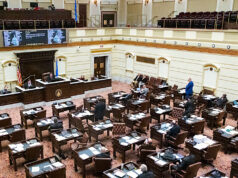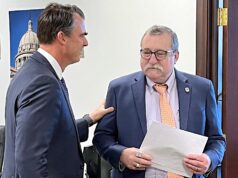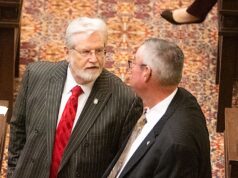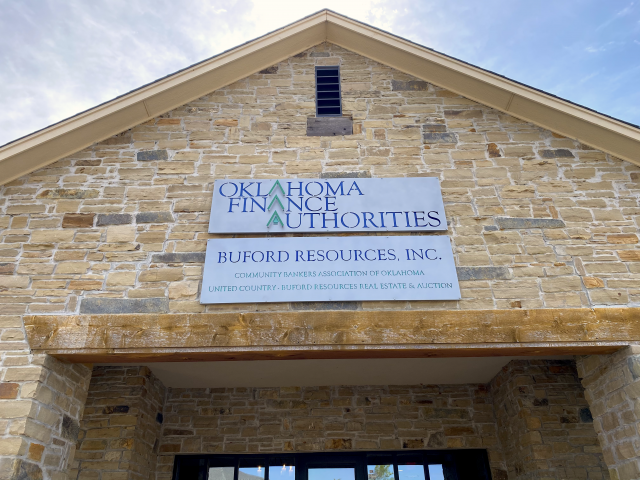

If people want to know how the Oklahoma Development Finance Authority will try to protect utility ratepayers from the financial calamity of February’s snowpocalypse by issuing up to $4.5 billion in low-interest bonds, they won’t be able to find it on the powerful but obscure agency’s website.
That’s because the ODFA does not have one. Neither does its counterpart, the Oklahoma Investment Finance Authority, a constitutionally created entity that also issues bonds that are loaned to local industrial development authorities.
“We manage two separate legal entities of the state of Oklahoma, and we do that with five employees,” said Mike Davis, president of the ODFA and OIFA. “The bottom line is we just do not have the resource to stand up and maintain a website.”
Most state boards maintain a digital presence that chronicles their basic details:
- public meetings, past and future
- general responsibilities
- staff roles and contact information
- board membership (embedded at the end of this article)
- applicable laws and rules
By not maintaining that information in a public-facing medium, ODFA and OIFA largely avoid the sunlight of the internet. Learning of the virtual void hours before voting to authorize ODFA to issue what might be $4.5 billion in bonds, lawmakers acknowledged a transparency concern.
“I have a hard time buying, ‘We just don’t have the resources.’ I mean, it’s not like it’s a big innovation. There are college kids all over who could build a website,” said Sen. Lonnie Paxton (R-Tuttle). “I would think in 2021, every state agency would have the ability to have a public website and we should expect that.”
Rep. Garry Mize (R-Guthrie) has been representing the House in securitization discussions, and he turned to sarcasm when told of the ODFA’s worldwide web absence.
“That’s exciting,” Mize said. “I can see where that might cause pause or concern.”
ODFA trying ‘to work through all the details’
Beyond administering state business incentive programs and being a conduit for other public bond projects, Davis said his main concern is figuring out how to pool an absurd assortment of storm-related utility debts before issuing and selling a slew of bonds that could be more than triple any other project in ODFA history.
“I know a lot of people want answers, but the reality is I think there are still some questions,” he said. “I think it’s a viable solution, but I think it’s going to take a little time to work through all the details.”
Davis made his remarks Tuesday morning, hours before SB 1049 and SB 1050 had been released publicly by the Legislature. Davis said he only received the proposed bill language after Monday afternoon’s press conference, which he watched in an effort to learn more about what the Legislature will be asking his agency to do.
“If this thing really is $4.5 billion, I can tell you the authority has never seen anything like that since 1974 when it was created, and likely will never see anything like that again,” Davis said.
The unique nature of this proposal — at least in Oklahoma — means many questions remain unanswered, including how the debts (and revenue streams) of potentially dozens of municipal power authorities (and other entities) will be pooled and sold.
“That is not known yet,” Davis said. “These are some of the myriad questions that I’ve got to get answered. I don’t know the answer to that yet.”
Mize said the situation has presented a learning curve for many people, including himself.
“I would say the biggest hold-up was probably getting everybody either in the room or on the same page. It’s a really complex problem, and even though you’re the governor, it doesn’t mean you know all things about all issues,” Mize said. “It’s the same thing with representation from the House. I’m the Utilities (Committee) chairman, but my real experience with utilities started two and a half months ago. Up until that point, [my experience] was paying my OG&E bill. So there was a lot to get up to speed on and then getting everybody on the same page and moving in the same way.”
Mize said he believes the Oklahoma Corporation Commission has been compiling a list of affected entities whose ratepayer debts may qualify for the relief programs proposed in the two Senate bills.
“This is the first step of what might be many to address this problem in its entirety. But we need this bucket open,” Mize said. “So if you think about it from passage to when those bonds are issued, and let’s say it’s six months. Well, in six months timeframe, the AG might wrap up their investigation, they found a bunch of stuff and there was federal aide and we have money to take care of all of it and make it go away and we don’t even need [this]. But, if that doesn’t happen, this has to be put in place so that we get to that place.”
‘It’s on the consumer’
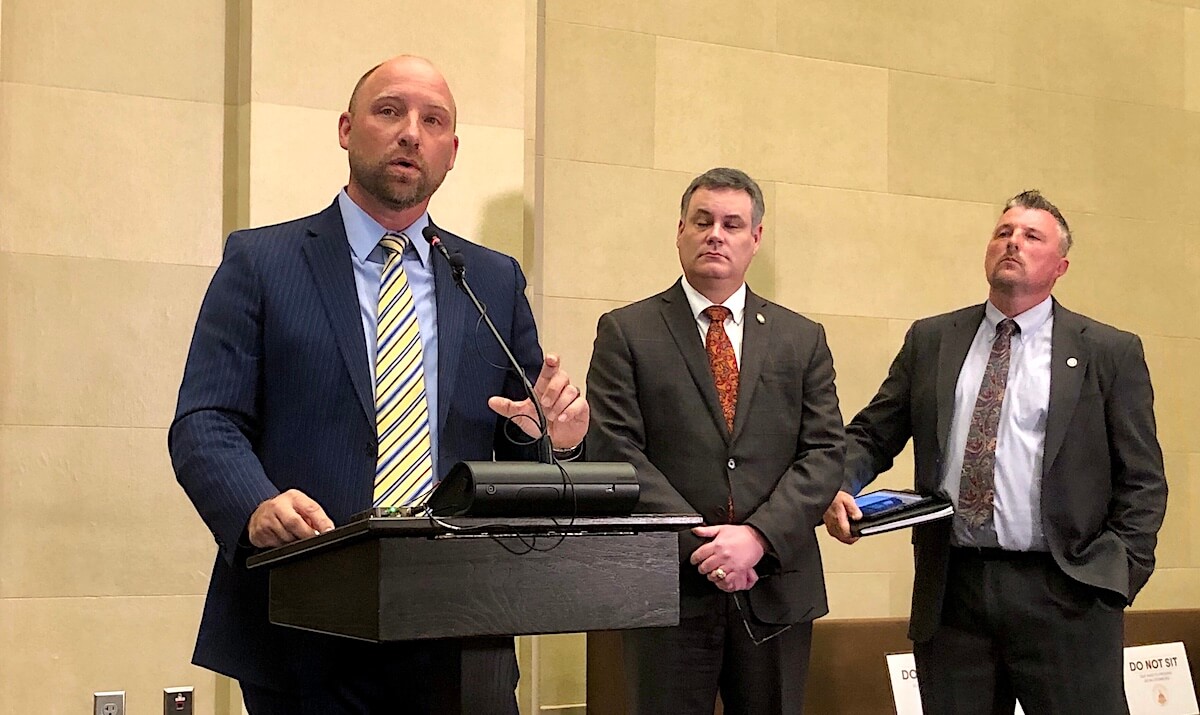
This afternoon at 2:45 p.m., SB 1049 and SB 1050 are set to be considered in Senate and House Joint Committee on Appropriations and Budget meetings. The JCAB process limits the ability for bills to be amended and is typically reserved for significant legislation with fiscal impacts on the state. Technically, any ODFA-issued bonds will not be on the state’s balance sheet, and the purpose of SB 1050 is to limit costs to ratepayers by allowing “regulated utilities” such as OG&E, ONG and PSO to carry their ratepayers’ debt off of their books as well. SB 1049 sets up a similar option for “unregulated utilities,” which are smaller power authorities not governed by the Corporation Commission.
Both regulated and unregulated utilities incurred enormous costs during the February storm owing to increased electricity and natural gas usage and a market spike in the price of natural gas.
Mize said the Oklahoma Municipal Power Authority has a plan to obtain its own financing, but has told him that “if the terms end up being better in the pooled financing piece” they will use the ODFA’s bond process if it is better for ratepayers.
Likewise, Mize said he has been told that ONG wants to participate in the state securitization plan and that his understanding is that PSO and OG&E have been less committal so far owing to their potential to obtain other financing.
“It took me a second to figure this out because they were saying, ‘Well, if we do this it’s not on the state’s balance sheet and we’re taking it off of the utility’s balance sheet.’ And I said, ‘Well whose balance sheet is it on?’ It’s on the consumer,” Mize said. “The consumer was purchasing power, and [the utility] has a constitutional duty to provide it. So it took me a minute to wrap my mind around that because most of us think, ‘Well I was just turning the lights on.’ No, you’re buying power, too. I think it’s important to not make [regulated utility companies] out to be the villain in this deal.”
Where the state’s largest electricity providers could hear criticism, however, would be if they reject participation in the proposed ODFA securitization program and carry their own financing of their ratepayers’ debts. State law allows regulated utilities to earn interest in that scenario based on the “weighted average cost of capital.”
“On $1 billion, that is a lot of money,” Mize said. “So the numbers we were given is that if we allow those regulated entities to carry that, then it’s going to cost the ratepayer an extra $1 billion, and we didn’t want to do that because we didn’t have to.”
If the Corporation Commission has concern about that interest earning, the three-member regulatory body could force the major utilities to abandon plans for private financing and instead participate in the state securitization program.
RELATED
How Oklahoma’s securitization plan intends to limit storm-related utility bills by Tres Savage
Asked if they will participate in the state’s securitization program or pursue private financing, OG&E lead communication specialist David Kimmel was noncommittal.
“We will continue to work with the [Oklahoma Corporation Commission] and state leaders to determine the best course of action for our customers,” Kimmel said.
Tiffini Jackson, vice president for external affairs with Public Service Company of Oklahoma, offered a similar statement that did not commit to participation.
“We appreciate having this option available as we look for solutions to deal with these extraordinary costs,” Jackson said. “Securitization can be a valuable tool when it’s structured in a way that aligns the short and long-term interests of our customers and the company.”
Davis emphasized the need for Oklahoma to create a securitization program, even as he emphasized remaining uncertainty around the situation.
“This is a proposed solution, and there is still a lot of work ahead of us. I don’t know what all work has gone on up to this point in time, but certainly we’re going to have to do quite a lot of work here to make this happen,” Davis said. “I think it is important to get utility ratepayer relief to the state. I’ve seen different stories, I’ve heard different numbers. Some of the numbers that came out of that conference yesterday are mind blowing and they’re not sustainable. There has to be some solution to get the state of Oklahoma relief.”
Bills advance from JCAB
Wednesday afternoon following the publication of this article, both SB 1049 and SB 1050 advanced unanimously from House and Senate JCAB meetings. During his presentation of SB 1049, Mize noted that the measure had been amended to specify that the ODFA “can charge an administrative fee for issuing the bonds.”
Oklahoma Development Finance Authority 2021 board members
At NonDoc’s request, the Oklahoma Development Finance Authority provided a document listing the membership of its board. The board typically meets at 10 a.m. on the final Wednesday of each month at its offices, 9220 N. Kelley Ave. in Oklahoma City.
 Loading...
Loading...
(Editor’s note: Public Service Company of Oklahoma made a charitable sponsorship to support the Sustainable Journalism Foundation in late 2020. This article was updated at 5:22 p.m. Wednesday, April 14, to note the advancement of SB 1049 and SB 1050.)











